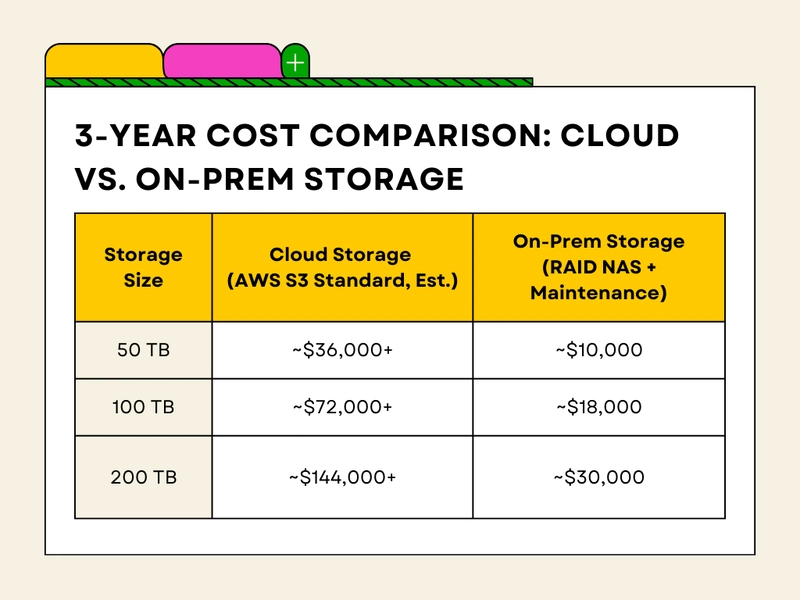Cloud vs. On-Prem Storage: The Hidden Costs No One Talks About
Cloud storage is everywhere — fast, flexible, and convenient. For many teams, it seems like the obvious choice. But as your organization grows, and especially if you're handling large volumes of media or creative assets, the math starts to shift. Let’s explore why on-premise storage often turns out to be the smarter long-term move. The True Cost of Cloud Storage Cloud providers like AWS, Azure, and Google Cloud often advertise low prices like $0.02/GB per month. Sounds like a bargain — until you look closer. What You’re Really Paying For: Storage costs per GB: Monthly recurring cost Data transfer and bandwidth: Downloading your own data can cost more than storing it API and access fees: Retrieving files or running batch operations often comes with a price tag Retrieval time: Cold storage options are cheap — until you need something quickly Data egress: Moving your files out of the platform? Get ready to pay With every gigabyte and every team member added, your bill grows. And it never stops. The On-Premise Advantage Setting up on-prem storage might sound old-school, but it gives you full control over both costs and infrastructure. Here’s why it works so well for growing teams: Upfront Investment, Predictable Costs You’ll pay for your hardware upfront — but that’s it. No recurring GB/month charges, no bandwidth surprises. Over time, this becomes significantly cheaper, especially if your data keeps growing. Full Control Over Security and Access Your data stays behind your firewall, under your policies. This is crucial for teams in regulated industries or handling sensitive files. High-Speed Local Access No delays, no bottlenecks. Your team works directly with files stored on the local network. Easy to Scale Adding more storage is as simple as expanding your existing infrastructure — without negotiating new contracts or facing unpredictable bills. Real-World Cost Comparison Let’s look at a simplified 3-year total cost of ownership (TCO) example for a team storing large media archives: Note: Cloud pricing includes basic storage only, excluding bandwidth, access, or retrieval fees. On-prem cost includes NAS server, HDDs, power, and basic IT maintenance. When On-Premise Makes Sense You work with high-resolution media, video, audio, 3D models, etc You expect your storage to grow steadily You value predictable budgeting You operate in a region with poor or unstable internet coverage You need fast access without cloud latency You care about data control, privacy, or compliance Bonus: Use a DAM to Maximize ROI You can now pair your NAS or file server with an on-prem Digital Asset Management system that integrates natively with your file storage. This allows you to manage and organize your growing archive in a modern, tag-based way — bringing structure and visibility to your entire asset library. When paired with a Digital Asset Management system, your on-prem storage becomes even more powerful. You can: Organize everything efficiently directly on your NAS or File Server Search and tag assets instantly (with AI tagging too) Control user access and roles Integrate with creative workflows (Photoshop, InDesign, Illustrator, etc.) One system I’ve found to work particularly well is Daminion — it integrates natively with your existing file server, giving you the same flexibility you expect from the cloud, but with the speed, security, and control of on-premise infrastructure, behind your firewall. Final Thoughts Cloud storage has its perks — especially for short-term, flexible needs. But for teams expecting consistent growth in their asset library, on-prem storage is a cost-effective, secure, and future-proof solution. Do the math for your team — you might be surprised.

Cloud storage is everywhere — fast, flexible, and convenient. For many teams, it seems like the obvious choice. But as your organization grows, and especially if you're handling large volumes of media or creative assets, the math starts to shift.
Let’s explore why on-premise storage often turns out to be the smarter long-term move.
The True Cost of Cloud Storage
Cloud providers like AWS, Azure, and Google Cloud often advertise low prices like $0.02/GB per month. Sounds like a bargain — until you look closer.
What You’re Really Paying For:
Storage costs per GB: Monthly recurring cost
Data transfer and bandwidth: Downloading your own data can cost more than storing it
API and access fees: Retrieving files or running batch operations often comes with a price tag
Retrieval time: Cold storage options are cheap — until you need something quickly
Data egress: Moving your files out of the platform? Get ready to pay
With every gigabyte and every team member added, your bill grows. And it never stops.
The On-Premise Advantage
Setting up on-prem storage might sound old-school, but it gives you full control over both costs and infrastructure. Here’s why it works so well for growing teams:
Upfront Investment, Predictable Costs
You’ll pay for your hardware upfront — but that’s it. No recurring GB/month charges, no bandwidth surprises. Over time, this becomes significantly cheaper, especially if your data keeps growing.
Full Control Over Security and Access
Your data stays behind your firewall, under your policies. This is crucial for teams in regulated industries or handling sensitive files.
High-Speed Local Access
No delays, no bottlenecks. Your team works directly with files stored on the local network.
Easy to Scale
Adding more storage is as simple as expanding your existing infrastructure — without negotiating new contracts or facing unpredictable bills.
Real-World Cost Comparison
Let’s look at a simplified 3-year total cost of ownership (TCO) example for a team storing large media archives:
Note: Cloud pricing includes basic storage only, excluding bandwidth, access, or retrieval fees. On-prem cost includes NAS server, HDDs, power, and basic IT maintenance.
When On-Premise Makes Sense
You work with high-resolution media, video, audio, 3D models, etc
You expect your storage to grow steadily
You value predictable budgeting
You operate in a region with poor or unstable internet coverage
You need fast access without cloud latency
You care about data control, privacy, or compliance
Bonus: Use a DAM to Maximize ROI
You can now pair your NAS or file server with an on-prem Digital Asset Management system that integrates natively with your file storage. This allows you to manage and organize your growing archive in a modern, tag-based way — bringing structure and visibility to your entire asset library.
When paired with a Digital Asset Management system, your on-prem storage becomes even more powerful. You can:
Organize everything efficiently directly on your NAS or File Server
Search and tag assets instantly (with AI tagging too)
Control user access and roles
Integrate with creative workflows (Photoshop, InDesign, Illustrator, etc.)
One system I’ve found to work particularly well is Daminion — it integrates natively with your existing file server, giving you the same flexibility you expect from the cloud, but with the speed, security, and control of on-premise infrastructure, behind your firewall.
Final Thoughts
Cloud storage has its perks — especially for short-term, flexible needs. But for teams expecting consistent growth in their asset library, on-prem storage is a cost-effective, secure, and future-proof solution.
Do the math for your team — you might be surprised.




















































%20Abstract%20Background%20112024%20SOURCE%20Amazon.jpg)






















































































































![[The AI Show Episode 142]: ChatGPT’s New Image Generator, Studio Ghibli Craze and Backlash, Gemini 2.5, OpenAI Academy, 4o Updates, Vibe Marketing & xAI Acquires X](https://www.marketingaiinstitute.com/hubfs/ep%20142%20cover.png)
























































































































































































































































-Nintendo-Switch-2-–-Overview-trailer-00-00-10.png?width=1920&height=1920&fit=bounds&quality=80&format=jpg&auto=webp#)





















_Anna_Berkut_Alamy.jpg?#)













































































































![YouTube Announces New Creation Tools for Shorts [Video]](https://www.iclarified.com/images/news/96923/96923/96923-640.jpg)





































































![[Weekly funding roundup March 29-April 4] Steady-state VC inflow pre-empts Trump tariff impact](https://images.yourstory.com/cs/2/220356402d6d11e9aa979329348d4c3e/WeeklyFundingRoundupNewLogo1-1739546168054.jpg)





























































